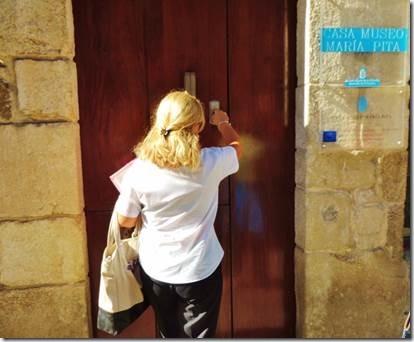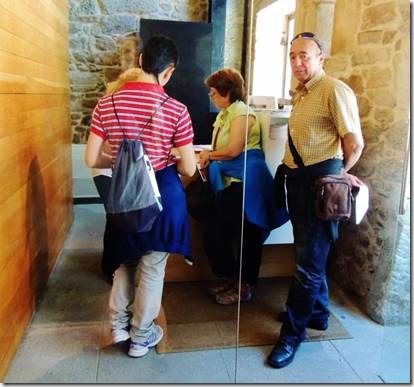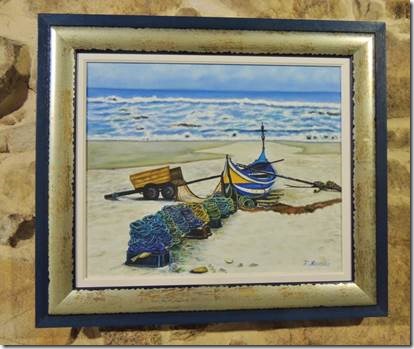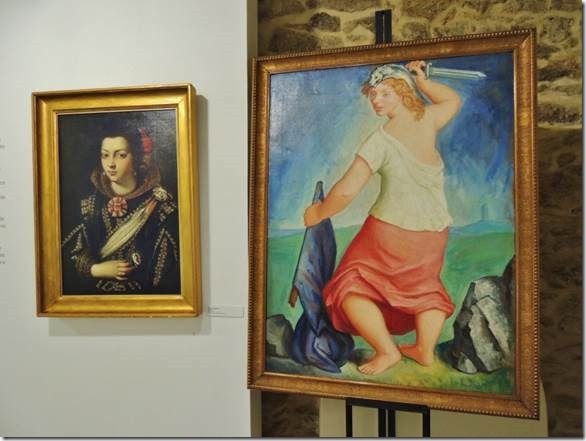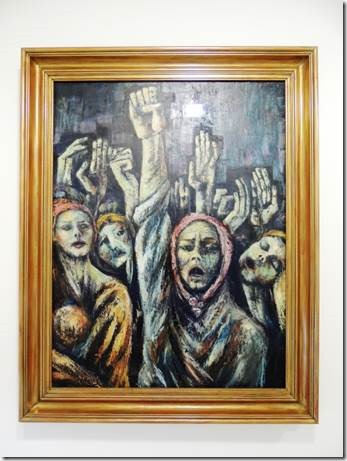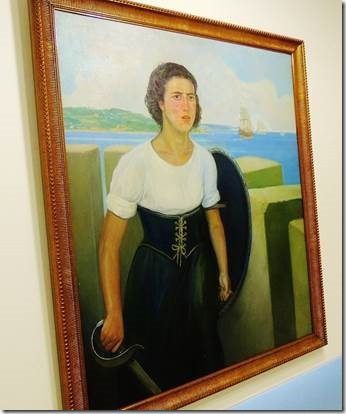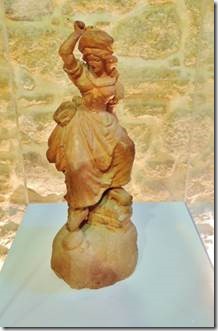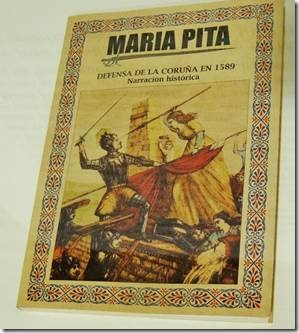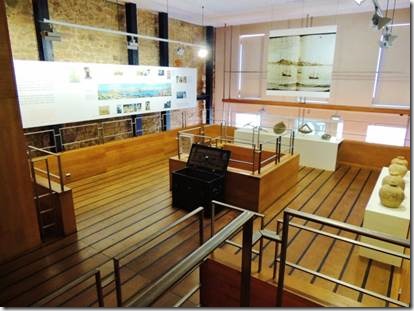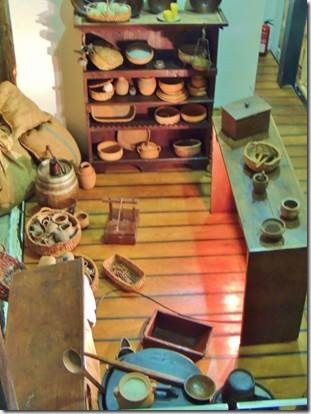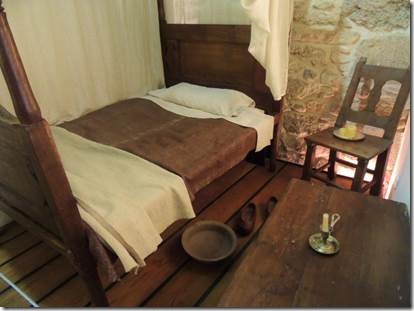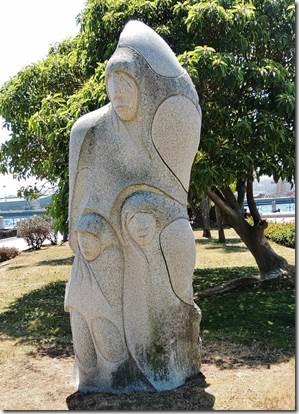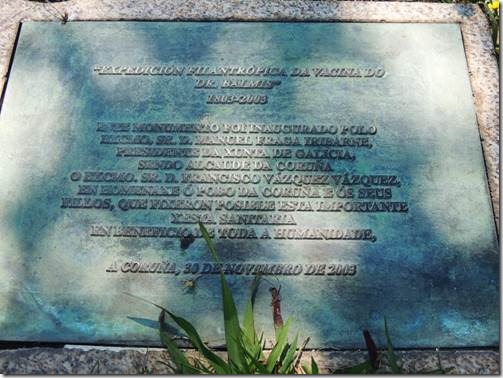Hola,
Yesterday, Sunday, I was walking to the supermarket and heard, “Virginia!” It was two women from our Picasso tour. One of them was from Coruña and one from near Madrid. Don’t know if they were sisters or friends. Maybe I’ll see them again and ask more. They spoke very fluent English. As it was I could have stayed and chatted longer because the grocery store was closed just as they had been in La Liῆea. I’ve no idea why I thought this store would be open. It certainly was crowded when we went early this afternoon.
Looks like the weather will keep us here until Friday so there’s more time to wander around here.
Ru
Maria Pita of La Coruῆa
Saturday while Randal slaved on the boat, I went off touring more of A Coruña. Hardly seems fair does it; but both of us were quite happy. I took the walking tour map and set off for Maria Pita House and Museum to see the current art exhibit of Fina Maroῆa Castiῆeiras. From the walking tour map I knew the museum was somewhere behind the A Coruῆa Information Office so set out in that direction. Would I have found it without some help along the way….I think maybe, but it would have taken me longer. The museum opened at 10:30 am but someone had forgotten a key so it was a bit later. However that gave me time to talk with a lovely family from Madrid. Lucky for me their teenage son was extremely fluent in English as his mom was the one who learned of the forgotten key and he could tell me. The family had been to many of the national parks in the US as well as Delaware. Not sure why Delaware, but the son had been with a family there I believe so maybe he’d been an exchange student. He said the people in the United States were very nice and friendly! Hurrah. Very nice, helpful people. I told them about the Francisco Xavier Balmis statue commemorating the 200th anniversary of the expedition that left from A Coruῆa in 1803 to eradicate small pox in the Spanish colonies in the Americas and elsewhere in the world.
|
Opening the door to the museum. The Madrid family had booked an afternoon tour of the Pillars of Hercules so had little time to spare waiting for the museum to open. My day was free, but I didn’t want to have to find the museum again, so I planned to wait quite a while to see what would happen. As it was the doors opened maybe 10 minutes late, so no problem for anyone. |
|
The lovely family from Madrid |
|
While this family and several others went off to learn about Maria Pita and A Coruῆa history I went off to the small art exhibit. The painting in the advert that had tempted me to the exhibit wasn’t there; but there were two I quite liked though they’re oil and I’ve become partial to watercolor, pen and ink, or just sketches. |
|
My friend Heidi did a series of painting based on the story of a red chest of drawers. Wonder where these shoes will show up next? http://www.heiditrautmann.com/ |
|
Reminds me of Van Gogh’s Saintes-Maries scenes of boats on the beach |
|
Maria Pita, Heroine of La Coruῆa “Maria Pita herself came to notoriety as a result of her role in Sir Francis Drake’s attack on A Coruna in 1589 and she is credited with playing a critical part in reducing the losses of the Corunans during this assault.” http://www.galiciaguide.com/Maria-Pita-square.html “The invading force vastly outnumbered the defenders. The failure of the English attempts to break into the city can only be explained by the local’s obstinated resistance and in particular, by the active rold of women. Over time the figure of Maria Pita became a symbol of heriism.” Maria Pita House Museum Brochure Images of Maria Pita The artist of the small painting is unknown; the larger one was by Isaac Diaz Pardo, 1946. I believe these are not the originial, but I’m not sure This painting was included with those of Maria Pita but with no explanatory plaque. I might just have to return to the museum and ask. The one museum staff person was busy with the Madrid family and I didn’t want to interupt…or wait…so I just don’t know. My take would be contemporary women protesting right-wing or even far left wing dictatorships in the Americas. |
|
I’ve no idea about these either as there was no plaque by the painting and the statue had a plaque in Spanish. All information other than the small brochure was in Spanish. |
|
“We conserve a considerable amount of details concerning Maria Pita’s life, thanks in part to her litigating character and her stubbornness in claining the compensation granted by the king in recognition of her role during the english siege. She died in Sigras, in the parish or Cambre, in 1643, at over 80 years old.” Maria Pita House Museum Brochure |
|
In Room II, we come across a water painting of A Coruña by Pier María Baldi, showing the city’s morphology in the 17th century and how it was divided into two cities – the Old Medieval City and La Pescadería. |
Finally, in Room III, which concerns the siege, we can highlight the copies of maps of A Coruña and Ferrol in 1589, whose originals are in the Library of Congress de Washington, and were previously unpublished in Spain. Other documents in the section whose originals are also at the Library of Congress are the facsimile of the Narrative of the Expedition of Francis Drake and John Norris in 1589, in Latin, and an extract from the expedition accounts book.
One of the María Pita House Museum’s main goals is to provide information about the heroine of A Coruña and explain the framework of her lifetime in the 16th and 17th centuries. This was a significant period in the history of the city, as this was when it acquired the administrative and military functions that would define its future evolution.
|
Both similar to utensils and furniture in colonial America The museum is a wonderful old stone building of a half-dozen floors. The brochure says the building is the same site as the original home, but not the original building. |
The site the museum is built on is the same site where María Pita’s family owned a house in the 16th century. It was originally the property of the heroine’s first husband, Juan Alonso de Rois, who inherited it from his grandmother. When her husband died, the house came into the hands of their daughter, María Alonso de Rois, although her mother and guardian, María Pita, lived there in usufructure. I don’t know if usufructure is a word but usufructuary is and it’s what you might have guessed from reading the sentence. Usufructuary Rights : A Civil Law term referring to the right of one individual to use and enjoy the property of another, provided its substance is neither impaired nor altered. http://www.google.com/
The museum is open Tuesday to Saturday from 10:30 to 14:00 and 17:30 to 20:00, Sundays and bank holidays from 10:30 to 14:00. It is closed on Mondays. http://www.coruna.es/
Drake and La Coruña, Spain (Drake who is not the hero here as he is in England as you can well imagine.)
Michael Turner http://www.indrakeswake.co.uk
Drake was off the coast of Spain in 1589 leading an English Armada to vanquish the remaining Spanish ships that had made it home, after being battered by storms off the rocky coasts of Scotland and Ireland.
Drake captured the lower town and was repulsed at the upper walled town. The queen had not supplied the siege gun and the mines had not been effective, against such solid walls. Even the casual visitor to La Coruña cannot avoid learning about María Pita. Squares and streets bear her name, and signs direct the visitor to her house. In an era when it was more of a man’s world, she inspired the inhabitants to stand their ground during the peak of the battle. Perhaps Drake was never aware that one of his most formidable adversaries was a woman!
Hymn To María Pita
On the horizon
A fleet, enemy ships
Advances in iron formation.
Bugles are sounding
Bells are ringing
To the city walls!
To repulse the invasion!
The cannons spew shrapnel
The enemy attacks ferociously
Smashing down the defendants
Who lose their life and become worthless.
Within the city walls
In the blood and fire
Amongst the dead
You are searching for
The body of a beloved husband
The invader has just killed.
Tears of blood
The sword in your hand
You run towards the enemy shouting
"Women, children! We all must fight!
Oust the invader from our city!"
This exploit has passed into history
A woman and a city
María Pita and La Coruña
Already united forever, say freedom
Always united, they say freedom
María Pita and her city.
***************************************************************
Isabel Sendales y Gomez another A Coruña heroine.
I am reading Saving the World by Julia Alvarez which was recommended by our Lake Charbot friend Linda. Half of the story revolves around the role Isabel Sendales y Gomez plays in the Balmis expedition to eradicate small pox in the Spanish colonies. The expedition began here in La Coruña in 1803. A statue was erected to celebrate the 200th anniversary but the plaque makes no mention of Isabel.
|
Doctor Balmis and two of the orphans who were live carriers of the small pox vaccine. |
“ FRANCISCO XAVIER BALMIS (1753–1819). Born in Alicante, Spain, Balmis was a physician and army surgeon (physician to King Charles IV as of 1795) and a pioneer in international vaccination. In 1781, 1791, 1795, and 1798, Balmis travelled to America to collect plants; while there, he studied plant remedies for venereal diseases, having published the Tratado de las virtudes del agave y la begonia in 1794. Balmis first translated into Spanish the Traité historique et pratique de la vaccine (Tratado histórico y práctico de la vacuna) by French physician Jacques Louis Moreau de La Sarthe. The Spanish version included a foreword by Balmis himself that added and clarified information contained in the book. When it was decided that an expedition, the Real Expedición Filantrópica de la Vacuna (Royal Philanthropic Expedition of the Vaccine), would be set up to spread smallpox vaccination into all of the overseas Spanish territories, Balmis was appointed its commander. On November 30, 1803, the corvette Maria Pita left the Spanish harbor of La Coruña, with the expedition team: Balmis, Antonio Salvany (second in command), three surgeons, two first-aid practitioners, four male nurses, 22 children from the Casa de Expósitos (orphanage) of La Coruña, and Isabel Sendales y Gómez, the rectoress of the orphanage, who was charged with taking care of the children. These children were the initial carriers of the smallpox vaccine: sequentially vaccinated arm to arm every 9–10 days, they were a living chain of transmission. Other children in the countries where the expedition stopped became part of that chain. The journey around the world took almost four years and can be considered as the first global vaccination campaign. [See: García de los Ríos JE, Jiménez Gómez PA (2005) Bicentenario de la expedición Balmis de la vacuna (1803-06). Actualidad SEM” http://www.im.microbios.org/00covers/37backcovermarch07.htm
Julia Alvarez, author of Saving the World has this to say on her website: “Lots of good books have been published in commemoration of the Royal Smallpox Expedition’s bicentennial, 1803-2003. The problem is that most of them are in Spanish! (Most of these Spanish studies of the expedition are listed in the Acknowledgments at the end of Saving the World.)
There are two excellent studies in English. One is a long article by Michael Smith, "The ‘Real Expedición Marítima de la Vacuna’ in New Spain and Guatemala," which appeared in Transactions of the American Philosophical Society (Volume 64, Part I, 1974). I was able to obtain a copy through my college’s interlibrary loan department. (If everyone writes in to the APS, they might reprint that article.) The second study I recommend is Catherine Mark’s English translation of Gonzalo Díaz de Yraola’s The Spanish Royal Philanthropic Expedition: The Round-the-World Voyage of the Smallpox Vaccine, 1803-1810 (La vuelta al mundo de la expedición de la vacuna, 1803-1810), a facsimile of the 1948 edition (Madrid: Instituto de Historia, Consejo Superior de Investigaciones Científicas, 2003, ISBN 84-00-08172-2).”
http://saving-the-world.juliaalvarez.com/suggested-reading.php

